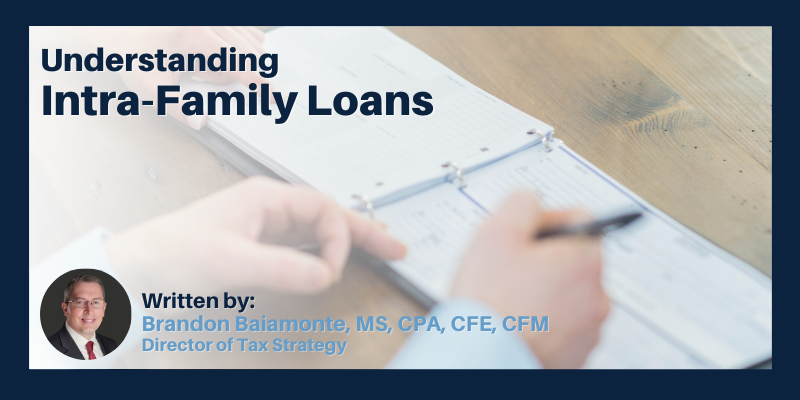
Do you have a family member who needs money for one of the following reasons?
• To buy a home;
• To start or grow a business;
• To purchase an investment;
• To buy a car or pay off credit card debt.
You may have considered loaning money to a family member. There are several advantages of loaning money to your loved one versus them going out and obtaining a loan. These include:
• The interest rate for a family loan is usually less than prevailing market rates;
• Interest payments aren’t made to banks or other lenders. This keeps the interest “in the family”;
• It may be the only source of funding for family members with no credit or poor credit;
• Additional closing costs or other loan fees can be avoided;
• Wealth can be transferred without gift tax implications if the acquired asset appreciates in value.
There are also a few questions to think about before offering a family member a loan. Will lending to one child or other family members cause jealousy between the other family members? Will there be hurt feelings and animosity if the family member fails to pay back the loan?
The 4-1-1 on Intra-Family Loans
There are some important rules to follow if you decide to make the loan. Otherwise, the IRS might come back and claim that your loan was actually a gift. If this occurs, you might be on the hook to pay gift taxes (more on that later).

Important tax rules to follow are:
1. Have a written loan agreement. This is usually in the form of a promissory note.
2. Establish an interest rate at or above the applicable AFR rate at the time the loan originates. The IRS publishes these rates each month. The annual AFR rates for July 2022 are:
-
-
- Short-Term Loans less than three years: 2.37%
- Mid-Term Loans between three and nine years: 2.99%
- Long-Term Loans greater than nine years: 3.22%
-
3. Establish a fixed repayment or amortization schedule. It’s generally easier to use a term loan rather than a demand loan structure.
4. The borrower should be solvent and have the ability and intent to repay the debt.
5. Demand the loan is repaid.
6. Maintain records to show the IRS you are treating this like a loan.
7. Consider adding security or collateral to the loan terms, if applicable.
Can You Forgive the Debt?
You might be wondering what happens if you’re considering forgiving the debt in the future. It depends on the following:
-
- Did you intend to forgive the debt at the time the loan was made? If so, then the IRS may consider the entire amount of the loan a gift at the time the loan was made.
- Did you decide to forgive the debt at some point after the loan was made? If so, then the loan balance at the time of forgiveness is considered a gift at that point in time.
Planning Tips and Income Tax Considerations
You can use the annual gift tax exclusion of $16,000 ($32,000 if married) to “forgive” part of the loan. Best practice is to make a gift to your family member and then have him or her use that gift to pay back part of the loan. You can make this gift each year if you want to help them pay back the loan. I would do it in two steps (as outlined) to create a paper trail in case the IRS comes asking questions.
To the lender: The interest income received by you is taxable as interest income at ordinary income tax rates. If the interest rate charged is less than the applicable AFR rate, you may owe income taxes on the interest that “should” have been charged. This is called imputed interest. In addition, the interest the borrower “should” have paid may need to be reported as a gift to the borrower.
To the borrower: Interest paid by the borrower may be deductible under certain circumstances, such as:
- The loan is used to purchase a qualified residence. The loan must be secured by the home to qualify.
- To purchase investments. The interest deducted may be limited to the amount of investment income.
- To start or grow a business. An example of a tax-deductible use of the funds would be to purchase equipment to expand a business venture.
It should be noted that interest isn’t deductible for funds used to purchase personal assets, such as a car (unless that car is used in a business).
Family Loans Can Work Well in Specific Situations
Family loans can be a great tool, but it’s important to be aware of and follow the rules to avoid IRS scrutiny.
Please reach out to your client advisor at Mission Wealth for more information. As always, it’s prudent to also discuss the tax consequences with your CPA.
How Mission Wealth Can Help
At Mission Wealth we work alongside our client families to align their financial plan with their biggest life goals and aspirations. Our highly experienced advisors specialize in identifying the challenges that are commonly experienced by families, in addition to leveraging unique opportunities for further family education and endowments.
If you or someone you know would like to schedule a free conversation, reach out using the form below or call our award-winning team at (805) 882-2360.
ALL INFORMATION HEREIN HAS BEEN PREPARED SOLELY FOR INFORMATIONAL PURPOSES. ADVISORY SERVICES ARE ONLY OFFERED TO CLIENTS OR PROSPECTIVE CLIENTS WHERE MISSION WEALTH AND ITS REPRESENTATIVES ARE PROPERLY LICENSED OR EXEMPT FROM LICENSURE. PAST PERFORMANCE IS NO GUARANTEE OF FUTURE RETURNS. INVESTING INVOLVES RISK AND POSSIBLE LOSS OF PRINCIPAL CAPITAL. NO ADVICE MAY BE RENDERED BY MISSION WEALTH UNLESS A CLIENT SERVICE AGREEMENT IS IN PLACE.
MISSION WEALTH IS A REGISTERED INVESTMENT ADVISER. THIS DOCUMENT IS SOLELY FOR INFORMATIONAL PURPOSES, NO INVESTMENTS ARE RECOMMENDED.
00456505 07/22
Share this Post

